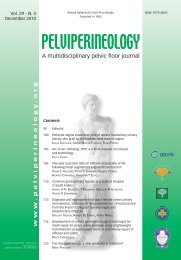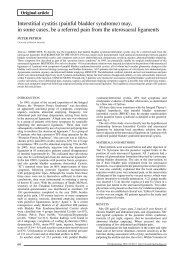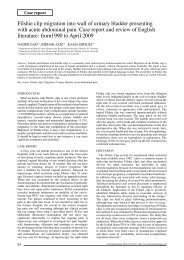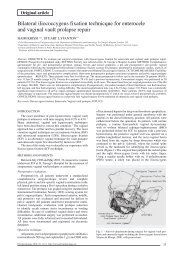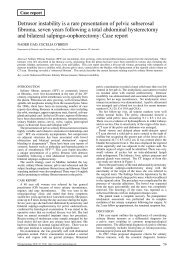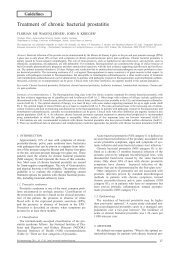This Issue Complete PDF - Pelviperineology
This Issue Complete PDF - Pelviperineology
This Issue Complete PDF - Pelviperineology
You also want an ePaper? Increase the reach of your titles
YUMPU automatically turns print PDFs into web optimized ePapers that Google loves.
V. Macchi - A. Porzionato - E. Vigato - C. Stecco - A. Paoli - A. Parenti - G. Dodi - R. De Caro<br />
Cambridge, UK). Immunohistochemistry used monoclonal<br />
anti-human alpha-smooth muscle actin (mouse IgG2a,<br />
kappa, Dako-Smooth muscle actin 1A4, Code No. M151,<br />
1:50 solution in phosphate-buffered saline) and monoclonal<br />
anti-rabbit sarcomeric actin (mouse IgM, kappa, Dako-Sarcomeric<br />
actin, Alpha-Sr-1, Code No. M874, 1:50 solution in<br />
PBS) (Dako A/S, Glostrup, Denmark). 21-23 The distribution<br />
of smooth and/or striated muscle fibers within the PVM was<br />
evaluated in the immunostained sections.<br />
RESULTS<br />
In coronal sections, stained with H.E. and a-M., the PVM<br />
was identifiable in 7/8 specimens (87.5%). It appeared as<br />
a fan-shaped layer of muscular tissue, located at the passage<br />
between the inferior (cranial level III) and middle third<br />
(caudal level II) of the vagina. Muscles fibres arise from the<br />
pubococcygeus muscle, run with an oblique course towards<br />
the lateral vaginal walls, where they mingle with the outer<br />
longitudinal fibers of the muscular layer of the vagina. From<br />
their origin the muscle fibres are progressively separated by<br />
loose connective tissue, forming a fan, with the apex corresponding<br />
to their origin from the pubococcygeus muscle<br />
and the base corresponding to the lateral walls of the vagina.<br />
At the level of the junction of the muscles fibres of the PVM<br />
and muscular layer of the vagina the mean thickness of the<br />
PVM is 1.8 ± 1.25 mm.<br />
In the transverse sections, the PVM was identifiable in 6/8<br />
specimens (75%). When the pubococcygeus muscle runs<br />
lateral to the vagina, a bundle of muscle fibres with oblique<br />
course splits from the medial margin of the pubococcygeus<br />
muscle towards the lateral walls of the vagina, mingling<br />
with the outer longitudinal fibers of the muscular layer of<br />
the vagina (Fig. 1). The mean thickness of the bundle of<br />
muscular fibres is 872 ± 56 micron. Other muscle fibers<br />
run towards the posterior vaginal wall, mingling with the<br />
longitudinal fibres of the vagina at the level of the lateral<br />
thirds of posterior vaginal wall. In 3/8 cases (37.5%) some<br />
muscle fibers were recognizable along the midline, between<br />
the posterior vaginal wall and the rectovaginal septum.<br />
Immunohistochemical staining showed that the PVM consisted<br />
predominantly of striated muscle fibers. At the level<br />
of the midline, between the posterior vaginal wall and the<br />
rectovaginal septum, sparcely smooth muscle fibers were<br />
Fig. 1. – Magnification of a transverse section of a female pelvic<br />
block showing the pubococcygeus muscle (PCM) and the lateral<br />
wall of the vagina. A bundle of muscle fibres of the pubovaginal<br />
muscle (PVM) run towards the outer longitudinal fibers of the<br />
muscular layer of the vagina (LMV). Note the longitudinal and<br />
transverse course of the muscular fibres of the PCM (azan Mallory<br />
staining, original magnification X 1.25).<br />
recognisable. At the boundary between the PVM and the<br />
vagina, obliquely running muscle fibres were recognizable,<br />
connecting the PVM with the outer longitudinal muscular<br />
layer of the vagina.<br />
DISCUSSION<br />
The levator ani muscle plays a critical role in supporting<br />
the pelvic organs. 24-26 Standring et al. 1 subdivide the levator<br />
ani muscle into the ischiococcygeus, iliococcygeus and pubococcygeus<br />
portions. The pubococcygeus muscle is often<br />
subdivided into separate parts according to the pelvic viscera<br />
to which they relate, i.e. pubourethralis and puborectalis<br />
in the male, pubovaginalis and puborectalis in the female.<br />
At the level of the vagina, the muscle bundles of the pubococcygeus<br />
muscle, are continuous with those controlateral,<br />
forming a sling (pubovaginalis and puborectalis).<br />
1, 15<br />
Testut and Jacob 27 reported that at this level a dense and<br />
compact connective tissue is interposed between the vagina<br />
and the levator ani muscle, that links each other. Cruveilhier<br />
28<br />
described that small fibres of the levator ani muscle penetrate<br />
into the vaginal wall. More recently, Guo and Dawei<br />
29<br />
in their radiological study of the pelvic floor, describe the<br />
PVM, located 3 mm below the puborectalis plane, indicating<br />
it in the axial section of MR imaging – PDW turbo<br />
SE sequences – in the component of the pubococcygeus<br />
muscle in proximity of the vagina. Our findings show that<br />
in the transverse sections the PVM is a dependence of the<br />
pubococcygeus muscle, from which splits at the level of the<br />
vagina. The muscle fibers show an oblique course and connect<br />
to the longitudinal fibres of the outer muscular layer of<br />
the vagina by oblique decussating fascicule at the level of<br />
the lateral vaginal walls and the lateral thirds of the posterior<br />
vaginal wall. So rather than a sling, the PVM is closely connected<br />
to the vagina, closing it on the lateral and posterior<br />
aspects.<br />
As regards muscle characteristics, the PVM origins from<br />
the striated muscular fibres of the levator ani muscle.<br />
DeLancey and Starr 16 describe the presence of smooth<br />
muscle, collagen and elastic fibers of the vaginal wall<br />
and paraurethral tissues that directly interdigitate with the<br />
muscle fibers of the most medial portion of the levator ani.<br />
Our study shows that the PVM consists predominantly of<br />
striated muscle fibers, mainly located at the level the lateral<br />
vaginal walls and the lateral thirds of the posterior vaginal<br />
wall; these muscle fibers origin directly from the striated<br />
levator ani muscle. On the other hand, sparce smooth muscle<br />
fibers have been recognisable, located at the level of the<br />
midline, between the posterior vaginal wall and the rectovaginal<br />
septum. These fibres could ascribed to the component<br />
of smooth muscle fibers recognisable at the level of<br />
the rectovaginal septum, that is located in an oblique coronal<br />
plane, close to the posterior vaginal wall, and is formed of a<br />
network of collagen, elastic fibres, smooth muscle cells with<br />
nerve fibres, emerging from the autonomic inferior hypogastric<br />
plexus, and variable numbers of small vessels. 30-31 We<br />
must also be considered that the age group in all the studied<br />
cadavers were 54-72 years old. Thus, the histological<br />
structure, the characteristics and topography of the PVM in<br />
younger women, especially nulliparous, may be different.<br />
From the functional point of view the PVM plays a role in<br />
the static and dynamic of the pelvic floor. In rectocele, failure<br />
of support of the rectum and perineum by the puborectalis<br />
and pubovaginalis muscles contributes to the prolapse<br />
by allowing descent of the posterior perineum during straining.<br />
1 With particular reference to the role on the vagina, the<br />
contraction of PVM approaches the posterior vaginal wall to<br />
the anterior one 27 and elevates the vagina in the region of<br />
the mid-urethra. 15 Shafik 4, 32 attributed to the contraction of<br />
8



